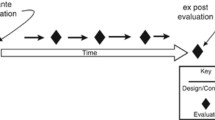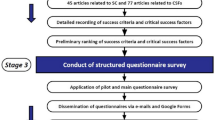Abstract
Analogy based estimation framework is developed aiming to estimate design rework efforts which are unnecessary repetition design efforts. Design rework factors were captured from literature reviews and then they were developed to be design rework drivers by mapping with results from semi structure interviews with three companies in automotive industries. There are six design rework drivers for probability occurrence, and there is only one driver for efforts required. Design structure matrix is used to identify interactions and addressed a key critical component or subsystem. The analogy based estimation framework is applied with the water pump development project from an engine manufacturer. The initial statistical validation method called mean magnitude of relative error is implemented and the results are in acceptable range, while experts from company C agreed on the validity of design rework drivers and opportunity to improve the framework. The ultimate goal of this development is to develop a framework to estimate design rework efforts in the product design and development projects at the early stage.
Similar content being viewed by others
References
Arundachawat, P., Roy, R., Al-Ashaab, A., & Shehab, E. (2009). Design rework prediction in concurrent design environment: Current trends and future research directions, CIRP design.
Ballard, G. (2000). Positive VS negative iteration in design, In Proceedings of the international group for lean construction 8th annual conference (IGLC-8). Brighton, UK.
Bashire, H. A. (2000). Models for estimating design effort. PhD Thesis, Canada: McGill University.
Blocher E. J., Chen K. H., Cokins G., Lin T. W. (2005) Cost management a strategic emphasis. McGrawhill, New York, p 61
Bogus S. M., Molenaar K. R., Deikmann J. E. (2006) Strategies for overlapping dependent design activities. Journal of Construction Management and Economics 24: 829–837
Browning T. (2001) Applying the design structure matrix to system decomposition and integration problems: A review and new directions. IEEE Transaction on Engineering Management 48(3): 292–306
Browning T., Eppinger S. D. (2002) Modelling impacts of process architecture on cost and schedule risk in product development. IEEE Transaction on Engineering Management 49(4): 428–441
Büyüközkan G., Dereli T., Baykasoglu A. (2004) A survey on the methods and tools of concurrent new product development and agile manufacturing. Journal of Intelligent Manufacturing 15(6): 731–751
Chakravarty A. (2001) Overlapping design and build cycles in product development. European Journal of Operation Research 134: 392–424
Cho, S. H., & Eppinger, S. D. (2001). Product development process modelling using advanced simulation. In Proceedings of ASME 2001 design engineering technical conferences.
Clark K. B., Fujimoto T. (1989) Lead time in automobile product development explaining the Japanese advantage. Journal of Engineering and Technology Management 6: 25–60
Hoedemaker G. M., Blackburn J. D., Wassenhove L. N. V. (1999) Limits to concurrency. Journal of Decision Sciences 30(1): 1–17
Joglekar N. R., Yassine A. A., Eppinger S. D., Whitney D. E. (2001) Performance of coupled product development activities with a deadline. Management Science, 47(12): 1605–1620
Jun H. B., Ahn H. S., Suh H. W. (2005) On identifying and estimating the cycle time of product development process. IEEE Transaction on Engineering Management 52(3): 336–349
Jung J.-Y. (2002) Manufacturing cost estimation for machined parts based on manufacturing features. Journal of Intelligent Manufacturing 13(4): 227–238
Krishnan V., Eppinger S. D., Whitney D. E. (1997) A model-based framework to overlap product development activities. Journal of Management Science 43(4): 437–451
Loch C. H., Terwiesch C. (1998) Communication and uncertainty in concurrent engineering. Management Science, 44(8): 1032–1048
Mitchell V. L., Nault B. R. (2007) Cooperation planning, uncertainty, and managerial control in concurrent design. Journal of Management Science 53(3): 375–389
Render B., Stair R. M. (2000) Quantitative analysis for management. Prentice Hall International Inc, Englewood Cliffs NJ
Roemer T. A., Ahmadi R., Wang R. (2000) Time-cost tradeoffs in overlapped product development. Journal of Operation Research 48(6): 860–865
Roemer T. A., Ahmadi R. (2004) Concurrent crashing and overlapping in product development. Journal of Operations Research 52(4): 606–622
Saaty T. L. (2006) Fundamentals of decision making and priority theory with the analytic Hierachy process. RWS Publication, Pittsburgh, PA
Smith R. P., Eppinger S. D. (1997) Identifying controlling features of engineering design iteration. Journal of Management Science 43(3): 276–293
Stewart R. D. (1991) Cost estimating. Wiley, NY
Stone R. B., Tumer I. Y., Wie M. V. (2005) The function-failure design method. Journal of Mechanical Design 127: 397–407
Terwiesch C. H., Loch C. H., Meyer A. D. (2002) Exchanging preliminary information in concurrent engineering: Alternative coordination strategies. Journal of Organization Science 13(4): 402–421
Wang Z., Yan H. S. (2005) Optimising the concurrency for a group of design activities. IEEE Transactions on Engineering Management 52(1): 102–118
Xiao R., Si S. (2003) Research on the process model of product development with uncertainty based on activity overlapping. Journal of Integrated Manufacturing Systems, 14(7): 567–574
Yan J. H., Wu C. (2001) Scheduling approach for concurrent product development processes. Journal of Computers in Industry 46: 139–147
Yan H. S., Wang Z., Jiang M. (2002) A quantitative approach to the process modelling and planing in concurrent engineering. Journal of Concurrent Engineering: Research and Application 10(2): 97–111
Yassine A. A., Chelst K. R., Falkenburg D. R. (1999) A decision analytic framework for evaluating concurrent engineering. IEEE Transactions on Engineering Management 46(2): 144–157
Yassine, A. A., Whitney, D. E., & Zambito, T. (2001). Assessment of rework probabilities for simulating product development processes using the design structure matrix. ASME 2001 international design engineering technical conferences, computers and information in engineering conferences, Pittsburgh, Pennsylvania.
Yassine A. A., Sreenivas R. S., Zhu J. (2008) Managing the exchange of information in product development. European Journal of Operational Research 184(1): 311–326
Author information
Authors and Affiliations
Corresponding author
Rights and permissions
About this article
Cite this article
Arundacahawat, P., Roy, R. & Al-Ashaab, A. An analogy based estimation framework for design rework efforts. J Intell Manuf 24, 625–639 (2013). https://doi.org/10.1007/s10845-011-0605-6
Received:
Accepted:
Published:
Issue Date:
DOI: https://doi.org/10.1007/s10845-011-0605-6




